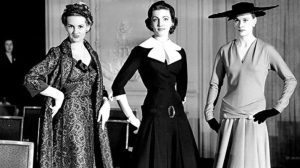British fashion was crucial in representing the considerable social, cultural, and political shift that occurred in the 1950s. It was around this time that World War II came to a conclusion and a new age of wealth and hope began. Hollywood’s impact was expanding, and women’s positions in society were changing. The blend of elegance, glamour, and utility that characterized british 1950s fashion produced a distinctive look that has withstood the test of time.
This essay serves as a sentimental ode to the classic look of British design from the 1950s and to its continuing influence on fashion history. We’ll look at the socio-historical background of the time period, the essential components of the fashion aesthetic, and the enduring influence of the 1950s on modern fashion and popular culture, as well as the period’s famous fashion idols. Come along on a trip through time to a bygone period of fashion that still serves as an inspiration for designers and fans of the industry today.
I. The Socio-Historical Context of British 1950s Fashion
The British 1950s fashion was heavily influenced by the socio-historical context of the time. The end of World War II saw a major shift in society, as women’s roles in society were changing, and there was a newfound sense of optimism and prosperity. After years of rationing and war, people were eager for change, and fashion was one way to express this.

Women’s fashion, in particular, reflected the changing attitudes toward women’s roles in society. With the war over, women were expected to return to their traditional roles as homemakers and mothers. However, many women were reluctant to give up their newfound independence and sought to assert their individuality through fashion.
Hollywood also played a significant role in shaping British 1950s fashion. Films such as Roman Holiday and Sabrina, starring Audrey Hepburn, introduced a new sense of elegance and glamour that was reflected in the clothing of the time. The rise of rock and roll music also gave birth to new fashion subcultures, such as the Teddy Boys and Girls, who embraced a rebellious and edgy style.
In summary, the socio-historical context of the 1950s had a significant impact on British fashion, with changing attitudes towards women’s roles, Hollywood’s influence, and the rise of rock and roll music shaping the style of the time. The resulting fashion style was a unique blend of elegance, glamour, and functionality that continues to inspire designers today.
II. Key Elements of British 1950s Fashion
The British 1950s fashion style was distinguished from other fashion trends of the era by a number of distinctive characteristics. These components represented the shifting views on women’s responsibilities in society, the impact of Hollywood, and the demand for pragmatism and utility.
The 1950s saw a feminine style for women’s clothing that highlighted a small waist and a voluminous skirt. Using tulle underskirts, petticoats, and crinolines, this was accomplished. It was typical to find polka dot, floral, and striped patterns on fabrics including cotton, silk, and wool. For daytime clothing, pastel hues were fashionable, whereas, for nighttime clothing, strong hues like red and black were preferred.
A sleek and refined appearance characterized men’s fashion in the 1950s. Single-breasted jackets and tapered trousers were the standards for the conventional suit, which remained in demand. Additionally common were items of casual clothing like chinos, knits, and polo shirts. Men’s accessories, like ties, fedora hats, and cufflinks, played a significant role in this era’s fashion.
Overall, a feminine silhouette for women’s clothing, elegant and well-tailored tailoring for men’s clothing, the use of useful materials and patterns, and the addition of accessories to complete the appearance were the major components of British fashion in the 1950s. These components represented the shifting views on women’s responsibilities in society, the impact of Hollywood, and the need for realism and usefulness.
III. Iconic British 1950s Fashion Icons
A sleek and refined appearance characterized men’s fashion in the 1950s. Single-breasted jackets and tapered trousers were the standards for the conventional suit, which remained in demand. Additionally common were items of casual clothing like chinos, knits, and polo shirts. Men’s accessories, like ties, fedora hats, and cufflinks, played a significant role in this era’s fashion.
Overall, a feminine silhouette for women’s clothing, elegant and well-tailored tailoring for men’s clothing, the use of useful materials and patterns, and the addition of accessories to complete the appearance were the major components of British fashion in the 1950s. These components represented the shifting views on women’s responsibilities in society, the impact of Hollywood, and the need for realism and usefulness.
Princess Margaret was another significant 1950s fashion icon. She was Queen Elizabeth II’s younger sister, and she was renowned for her bold and outlandish sense of style. She frequently wore daring necklines, high slits, and striking designs that marked her apart from the royal family’s more conventional fashion.
A rebellious and edgy sense of dress defined the 1950s subculture known as the Teddy Boys and Girls. Drainpipe pants, brothel creepers, and slim-fitting jackets with tiny lapels were favorites of the Teddy Boys. On the other side, the Teddy Girls preferred voluminous skirts, blouses, and cropped jackets.
In summary, the British 1950s fashion era gave rise to several iconic fashion icons, such as Audrey Hepburn, Princess Margaret, and the Teddy Boys and Girls. These fashion icons had a significant impact on the fashion trends of the time and continue to inspire fashion styles to this day.
IV. The Legacy of British 1950s Fashion
Today’s fashion trends are still influenced by the fashion of the British 1950s. The enduring and famous fashion of the time was characterized by a feminine silhouette for women’s clothing, elegant tailoring for men’s clothing, and the use of useful materials and accents.
The little black dress’ continuing appeal is among the most important relics of British design from the 1950s. The little black dress, made popular by Audrey Hepburn in the film Breakfast at Tiffany’s, has become a timeless wardrobe essential worn by women of all ages and on all occasions.
The trench coat’s enduring appeal is a key fashion legacy from the British 1950s. The trench coat, which was first created as a useful and functional item of clothing for troops, rose to popularity as a fashion item in the 1950s, in part because of its appearance in Hollywood films. Trench coats are still a common and fashionable outerwear item today.
The appeal of vintage and retro clothing is another indication of the 1950s’ impact. Retro and vintage clothes are now again popular, with designers infusing parts of the 1950s into their creations due to nostalgia for the era’s famous look.
V. Conclusion
In conclusion, British fashion in the 1950s was a heyday of style that now serves as an example to designers and devotees of the industry. The socio-historical context of the time, with its shifting views on women’s roles in society and the influence of Hollywood, contributed to the development of a distinctive style that was characterized by a feminine silhouette for women’s clothing, upscale tailoring for men’s clothing, and the use of useful fabrics and accessories.
A number of legendary fashion stars from the time, like Audrey Hepburn and Princess Margaret, who continue to influence fashion trends and styles today, were also born during this period. British 1950s design has had a lasting impression, as seen by the continuous vogue for vintage and retro clothing as well as the appeal of wardrobe essentials like the trench coat and little black dress.
Overall, the classic style of British 1950s fashion pays wistful homage to a bygone period, and its long-lasting legacy is evidence of its continuing influence on the fashion industry.
